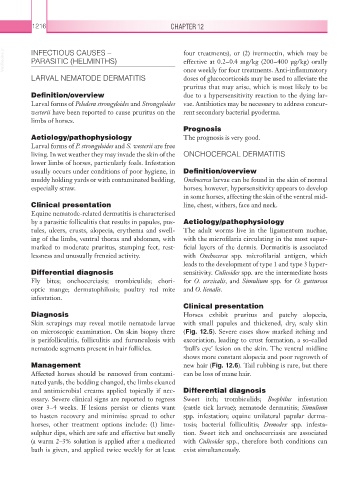Page 1241 - Equine Clinical Medicine, Surgery and Reproduction, 2nd Edition
P. 1241
1216 CHAPTER 12
VetBooks.ir INFECTIOUS CAUSES – four treatments), or (2) ivermectin, which may be
PARASITIC (HELMINTHS)
effective at 0.2–0.4 mg/kg (200–400 µg/kg) orally
LARVAL NEMATODE DERMATITIS once weekly for four treatments. Anti-inflammatory
doses of glucocorticoids may be used to alleviate the
pruritus that may arise, which is most likely to be
Definition/overview due to a hypersensitivity reaction to the dying lar-
Larval forms of Pelodera strongyloides and Strongyloides vae. Antibiotics may be necessary to address concur-
westerii have been reported to cause pruritus on the rent secondary bacterial pyoderma.
limbs of horses.
Prognosis
Aetiology/pathophysiology The prognosis is very good.
Larval forms of P. strongyloides and S. westerii are free
living. In wet weather they may invade the skin of the ONCHOCERCAL DERMATITIS
lower limbs of horses, particularly foals. Infestation
usually occurs under conditions of poor hygiene, in Definition/overview
muddy holding yards or with contaminated bedding, Onchocerca larvae can be found in the skin of normal
especially straw. horses; however, hypersensitivity appears to develop
in some horses, affecting the skin of the ventral mid-
Clinical presentation line, chest, withers, face and neck.
Equine nematode-related dermatitis is characterised
by a parasitic folliculitis that results in papules, pus- Aetiology/pathophysiology
tules, ulcers, crusts, alopecia, erythema and swell- The adult worms live in the ligamentum nuchae,
ing of the limbs, ventral thorax and abdomen, with with the microfilaria circulating in the most super-
marked to moderate pruritus, stamping feet, rest- ficial layers of the dermis. Dermatitis is associated
lessness and unusually frenzied activity. with Onchocerca spp. microfilarial antigen, which
leads to the development of type 1 and type 3 hyper-
Differential diagnosis sensitivity. Culicoides spp. are the intermediate hosts
Fly bites; onchocerciasis; trombiculids; chori- for O. cervicalis, and Simulium spp. for O. gutturosa
optic mange; dermatophilosis; poultry red mite and O. lienalis.
infestation.
Clinical presentation
Diagnosis Horses exhibit pruritus and patchy alopecia,
Skin scrapings may reveal motile nematode larvae with small papules and thickened, dry, scaly skin
on microscopic examination. On skin biopsy there (Fig. 12.5). Severe cases show marked itching and
is perifolliculitis, folliculitis and furunculosis with excoriation, leading to crust formation, a so-called
nematode segments present in hair follicles. ‘bull’s eye’ lesion on the skin. The ventral midline
shows more constant alopecia and poor regrowth of
Management new hair (Fig. 12.6). Tail rubbing is rare, but there
Affected horses should be removed from contami- can be loss of mane hair.
nated yards, the bedding changed, the limbs cleaned
and antimicrobial creams applied topically if nec- Differential diagnosis
essary. Severe clinical signs are reported to regress Sweet itch; trombiculids; Boophilus infestation
over 3–4 weeks. If lesions persist or clients want ( cattle tick larvae); nematode dermatitis; Simulium
to hasten recovery and minimise spread to other spp. infestation; equine unilateral papular derma-
horses, other treatment options include: (1) lime- tosis; bacterial folliculitis; Demodex spp. infesta-
sulphur dips, which are safe and effective but smelly tion. Sweet itch and onchocerciasis are associated
(a warm 2–3% solution is applied after a medicated with Culicoides spp., therefore both conditions can
bath is given, and applied twice weekly for at least exist simultaneously.

